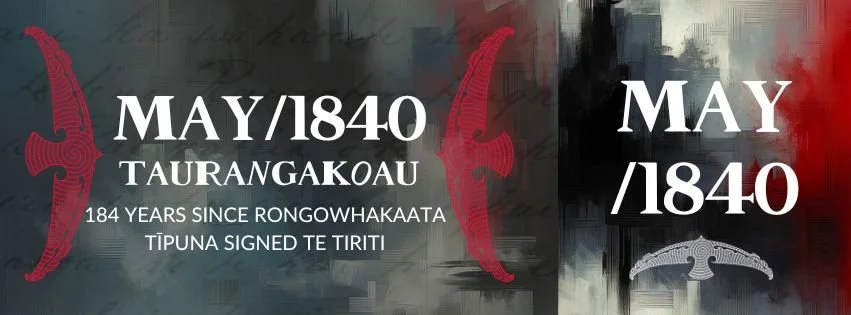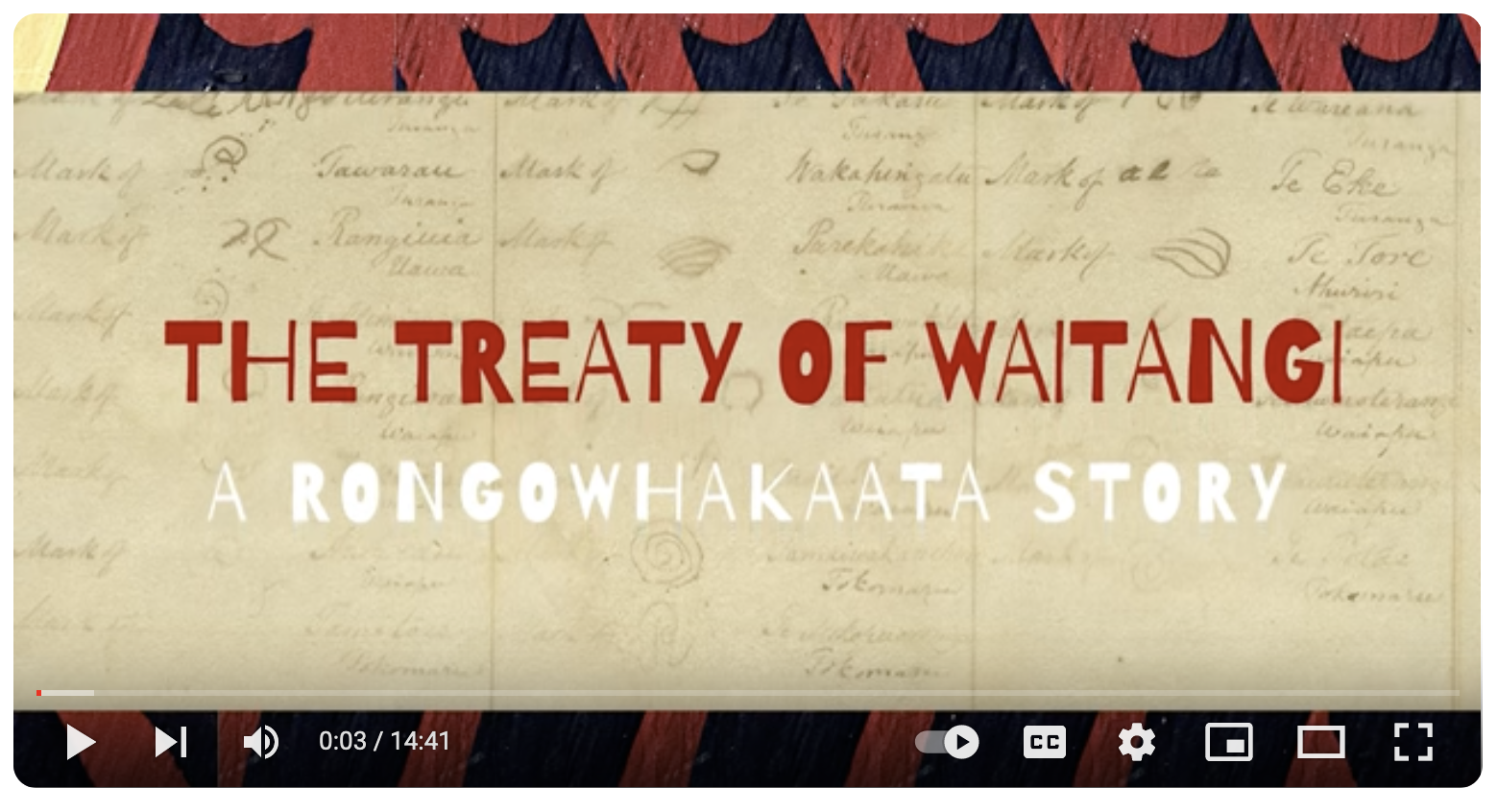The signing of Te Tiriti
184 years ago the Te Tiriti o Waitangi was signed by Rongowhakaata at Tauranga-kōau between the 5 -12 May 1840
24 Rangatira primarily of Rongowhakaata, Te Aitanga ā Mahaki, and Ngāi Tāmanuhiri descent gathered at Taurang-kōau in Manutuke to sign the Te Tiriti of Waitangi. At that period, Manutuke served as a hub for missionary activities and colonization, making it possible for the Treaty to be signed for the first time in Te Tāirawhiti.
Three decades later, the Crown effectively stripped Rongowhakaata of their land, leaving them with minimal territory, with Manutuke becoming ‘the reservation’, of remnant ‘carved-up’ whenua and disenfranchised whānau.
On this anniversary of the signing of the Te Tiriti we took a deeper dive with Tanith Wirihana to learn more about our tīpuna signatories.
About the Whenua: Tauranga-Kōau
After a heated dispute, Tārake fatally injured Te Hūkaipū near Tauranga-kōau. This event led to Ngāti Maru being evicted by Te Ikawhāingatā, with support from Konohi of Whāngārā mai tawhiti. Before leaving for the Waiapu district, Ngāti Maru set fire to Ōrākaiapu, Umukapua, and Rae-o-te-kapu pa, and took Te Ikawhāingatā’s son, Te Rātū, as a captive. Upon their return, Te Ikawhāingatā established Tauranga-kōau and named his residence ‘Kōtuku-manawa-rua.’
Eventually, after discussions with missionary Henry Williams, and with much hesitation, Te Tiriti o Waitangi was signed in this area between May 5 and 12, 1840, by 24 rangatira.
Te Tiriti signatory: Tamati Waka Māngere
Tamati Waka Māngere, the elder brother of Raharuhi Rukupo welcomed Reverend William Williams to reside at Ōrākaiapu pā in 1840, it is believed that he passed away shortly after signing Te Tiriti o Waitangi.
In 1841, Raharuhi Rukupo honored his brother's memory by constructing Te Hau-ki-Tauranga. Tamati Waka Māngere was laid to rest nearby at Te Kaupapa, alongside another Ngāti Maru signatory of the Te Tiriti, Te Kaingakiore. Inside Te Hau ki Tūranga, the epa often interpreted as a self-portrait of Rukupo is also thought to represent Tamati Waka Māngere, serving as a tribute within the whare.
In 1867, Te Hau ki Tūranga was stolen by Captain Reginald Biggs and Captain John Fairchild on behalf of the Minister of Native Affairs, J.C. Richmond, "with the tomahawk," despite objections from Ngāti Kaipoho, who protested against the removal of each plank.
Te Tiriti signatory: Enoka Te Pakaru
Enoka was a rangatira of Te Aitanga-a-Mahaki and Rongowhakaata, and also signed Te Tiriti o Waitangi. Enoka is attributed as being the composer of the waiata oriori Pō Pō, and one of the tohunga whakairo of Te Hau ki Tūranga. Two other signatories and rangatira, Te Hori and Tūhura, are believed to have been Matenga Te Hore and Rewiti Tauri Tūhura, who were among the tohunga whakairo that built Te Hau ki Tūranga.
Te Tiriti signatory: Wiremu Kingi Paiaterangi Te Apaapa
Also known as Wiremu Kingi, the rangatira of Ngāti Maru who signed Te Tiriti o Waitangi at Tauranga-kōau pā in Manutūkē.
He was among the people of Oweta that joined Te Kooti and he was present at the battle of Ngatapa, where summary executions were committed by Crown forces in the Crown's name and against the Crown's own laws. This is considered to be the darkest day in New Zealand's colonial history. After the battle, Wiremu escaped into the bush and survived for two nights and three days without food. “I was nearly dead when two men came to me; they lit a fire and gave me food – it was Mamaku, honey, and Kotukutuku.”
A poutokomanawa of Wiremu’s father, Te Apaapaoterangi (or Te Apaapa), is located within Te Mana o Tūranga, Whakato. His grandfather, Tūhura, was said to have been a rangatira at the arrival of Lt. James Cook (known to Rongowhakaata as Te Paia or “Fire” after the instructions he gave to shoot Te Rakau). The coat of red serge placed upon the body of Te Rakau by Hikirangi was known as Te Makura and also called Te Hinu a Tūhura.
Te Tiriti signatory: Paratene Tūrangi
Paratene Pōtoti, also known as Te Paratene, was a respected rangatira who signed Te Tiriti o Waitangi at Tauranga-kōau pā in Manutūkē. In 1855, the rangatira of Tūranga asserted their sovereignty when the government attempted to establish a magistrate. They firmly stated that they hadn't given up their land to the Queen, thus rejecting any authority imposed by the government. They insisted on being their own magistrates and opposed any appointment made by the Queen.
In May 1858, Paratene Tūrangi emphasized their autonomy, stating, "We are not the remnant of a people left by the Pakeha; we have not been conquered; the Queen has her island, we have ours; the same language is not spoken in both." Kahutia, another ranking rangatira of Ngāi Tawhiri, echoed this sentiment, asserting, "Let the Magistrate be under the Queen if he likes; we will not consent to Her authority, we will exercise our own authority in our own country."
Paratene's involvement in the in the deportation of Te Kooti and the whakarau to Wharekauri following the battle of Te Waerenga a Hikairirangi, Paratene led to his execution, along with five other leaders, on Te Kooti Rikirangi Te Turuki's orders at Oweta in 1868
Te Tiriti signatory: Matenga Tukareaho
A rangatira of Rongowhakaata, Ngāi Tāmanuhiri, and Ngāti Rakaipaaka. He was accused of murdering Te Rātau, father of Ihaka Whaanga, a charge he denied himself (although he was a member of the war party). His son, Haami Te Hauerangi, claimed it was his mother, Hineikoia, who organized a taua (war party) to avenge her uncle Akurangi’s death.
Later, after his conversion to Christianity upon his return from captivity in the North, Ihaka Whaanga said, “Matenga was the first Christian native preacher in the Wairoa district. When he returned from the Bay of Islands, he preached at Te Uhi...” He relocated to Te Māhia mai tawhiti, and then Tūranga, where he assumed the role of teacher at Umukapua pa with his son Paora Pōmare. Matenga was also a kaiwhakairo and was one of the builders of the whare nui Te Poho-o-Kahungunu at Pōrangahau in the 1870s.
Check out the video below to learn more about our Treaty story.


